27 September 2024 : Daily Current Affairs
1. Storms brewing in East, South China seas
- 1. Storms brewing in East, South China seas
- 2. A life in revolution: Bhagat Singh, a radical thinker and ideologue
- 3. India’s Oil Companies Struggle to Repatriate $900 Million in Dividends Stuck in Russia Amid Sanctions
- 4. Biden-Modi Meeting Strengthens India-US Ties Amid Strategic Tech Collaborations and Minor Diplomatic Challenges
- 5. Finance Ministry Flags Emerging Strains in Key Sectors, Highlights Strong Economic Growth Outlook
- PRELIMS FACTS
- 1. Keffiyeh: A Symbol of Palestinian Identity and Resistance Amid Controversy
- 2. Japan’s Historic Naval Passage Through Taiwan Strait Sparks Tensions with China
- 3. L69, G4 countries seek urgent reform of UN Security Council
- 4. Karnataka govt. withdraws general consent to CBI to conduct probe
- 5. Exploring the ‘wonderful world’ of symplectic geometry to solve problems in mechanics
- 6. World Rabies Day: tracing the journey from myths to modern medicine
- 7. Secretary, Dr. Devesh Chaturvedi chairs a review meeting of United Nations World Food Programme- Country Programme Advisory Committee
(Source – The Hindu, International Edition – Page No. – 10)
| Topic: GS2 – International Relations |
| Context |
|
Maritime East Asia: A Region of Power Politics
- In recent years, maritime East Asia has become a zone of intense power politics.
- The East China Sea, bordered by China, Taiwan, Japan, and South Korea, has been a hotspot due to China’s claims over the Senkaku/Diaoyu Islands, which are under Japanese control.
- The South China Sea is another flashpoint, with China asserting territorial claims that conflict with several Southeast Asian countries.
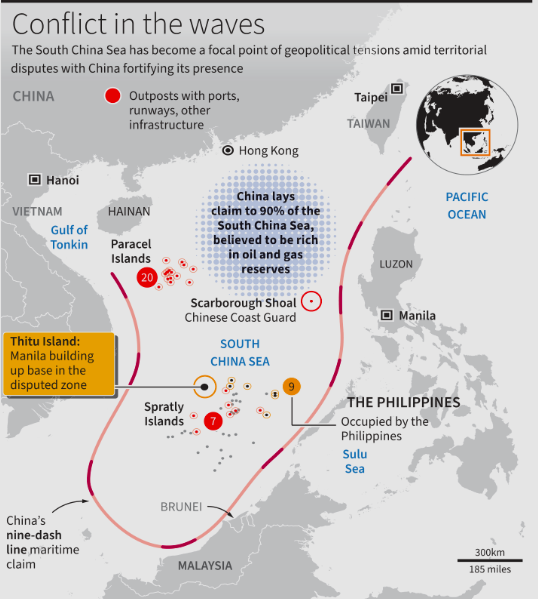
China’s Perspective and Actions
- China views the East and South China Seas through the lenses of sovereignty, territorial integrity, and national security.
- China’s 2019 Defence White Paper claims the South China Sea islands and the Diaoyu Islands as inalienable parts of Chinese territory.
- China has built defence-related infrastructure in the South China Sea and patrols the waters near the Diaoyu Islands.
- Regional countries view China’s actions as aggressive and provocative, despite China asserting they are defensive.
Significance of the Seas
- The South China Sea is a critical region for global maritime trade, with the Taiwan Strait being a vital chokepoint.
- The region is also home to undersea cables crucial to the global digital economy.
- The South China Sea contains vast reserves of untapped oil and natural gas, further increasing its strategic importance.
Regional Responses
- Regional countries have responded by increasing defence spending to catch up with China’s growing power.
- The Philippines has adopted a more assertive stance under President Ferdinand Marcos Jr., pushing back against China’s actions.
- U.S. treaty allies in the region, including Japan, South Korea, and the Philippines, are strengthening their defence cooperation with the U.S. to counterbalance China’s influence.
Concerns and Ongoing Issues
- Despite increased cooperation, there are concerns about the U.S.’ ability to maintain its security commitments in the Indo-Pacific, given its domestic political challenges.
- Some debate whether U.S. engagement in East Asia balances China’s power or exacerbates tensions in the region.
| PYQ: South China Sea has assumed great geopolitical significance in the present context. Comment. (200 words/12.5m) (UPSC CSE (M) GS-1 2016) |
| Practice Question: Discuss the strategic significance of the East and South China Seas in the context of regional power dynamics and global trade routes. How are China’s territorial claims impacting geopolitical stability in the Indo-Pacific? (150 Words /10 marks) |
2. A life in revolution: Bhagat Singh, a radical thinker and ideologue
(Source – The Hindu, International Edition – Page No. – 4)
| Topic: GS1 – Modern Indian History – Personalities. |
| Context |
|
Rich Legacy of Bhagat Singh’s Writings
- Bhagat Singh, a revolutionary who was martyred in the Indian freedom struggle, remains an erudite and polyglot figure who wrote extensively on diverse subjects like communalism, inequality, religion, and faith.
- His writings hold contemporary relevance and highlight his intellectual depth beyond mere political slogans.
Literary Contributions
- Bhagat Singh, proficient in Urdu, Punjabi, Hindi, and English, displayed an early understanding of language and culture. In 1923, at the age of 16, he wrote The Problem of Punjab’s Language and Script, explaining the Gurmukhi script and Punjabi language.
- In his jail notebooks, Singh emphasised Universal Brotherhood, advocating for equality and peace without penal codes, reflecting his vision for a fair society.
- Bhagat Singh drew inspiration from historical and global figures like Rana Pratap, Lenin, Washington, Savarkar, and Krishna, weaving together various ideologies to influence Indian youth.
Views on Communalism and Journalism
- In Communal Riots and their Solution, Singh criticised the role of journalists in stoking communal violence and emphasised the need for newspapers to educate and promote fraternity rather than ignite narrow-mindedness.
Students and Politics
- In his 1928 article, Students and Politics, Bhagat Singh argued against the notion that students should refrain from politics, asserting that political awareness is crucial for the nation’s youth to contribute meaningfully to the freedom struggle.
Untouchability and Social Justice
- Singh’s article, The Problem of Untouchability, encouraged marginalised communities to rise against social oppression, calling them the “backbone” of historic revolutions and urging them to lead a social revolution.
Revolutionary Ideals
- In What is Revolution?, Bhagat Singh articulated his vision for continuous societal change, where revolutionary forces prevent reactionary elements from holding back progress.
- He criticised both organised religion and the state for perpetuating mental and physical slavery in his work What is Anarchism? and his iconic Why I am an Atheist.
Challenging Religion and Embracing Atheism
- Bhagat Singh questioned the relevance of religion in the freedom struggle, viewing it as a divisive force. He believed in challenging faith and outdated systems to pave the way for social progress.
| Practice Question: Bhagat Singh’s literary works go beyond revolutionary slogans, offering deep insights into social justice, politics, and religion. Discuss how his writings contribute to contemporary understanding of communalism, inequality, and political engagement among youth. (150 Words /10 marks) |
3. India’s Oil Companies Struggle to Repatriate $900 Million in Dividends Stuck in Russia Amid Sanctions
(Source: Indian Express; Section: Explained; Page: 21)
| Topic: GS3 – Indian Economy GS2 – International Relations |
| Context: |
| The article discusses the challenges faced by Indian oil companies in repatriating $900 million in dividends from their Russian investments due to Western sanctions and financial restrictions following Russia’s invasion of Ukraine. |
Analysis of News:
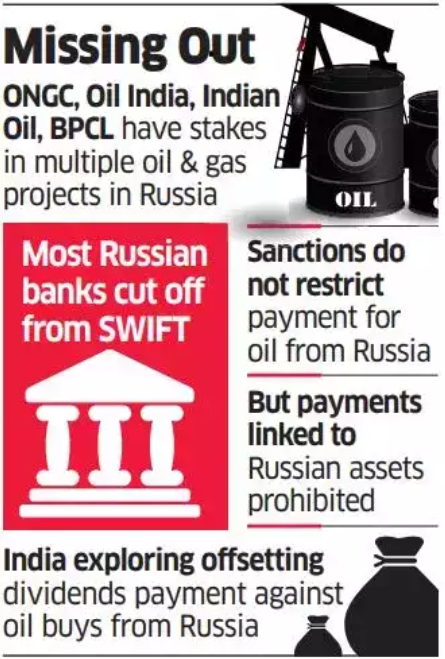
Accumulation of Dividend Income in Russia
- India’s public sector oil companies, including ONGC Videsh (OVL), Oil India (OIL), and Indian Oil Corporation (IOC), are facing difficulties in repatriating their dividend income from investments in Russian upstream oil and gas projects.
- Over the last two and a half years, nearly $900 million in dividends has accumulated in Russia, held in accounts of the Commercial Indo Bank (CIBL) in Moscow, due to complications arising from international sanctions.
Impact of Western Sanctions on Dividend Repatriation
- The key challenge in repatriating these funds stems from the Western sanctions imposed on Russia following its invasion of Ukraine in February 2022.
- Major Russian banks were excluded from the SWIFT financial transaction system, severely limiting Russia’s access to the global financial network.
- Additionally, Indian companies face complications due to the involvement of special purpose vehicles based in countries like Singapore, which adds to the legal and jurisdictional complexities.
Indian Investments in Russian Oil and Gas
- India has strategically invested in Russian energy projects as part of its energy security efforts. Indian oil companies have invested over $6 billion in Russia, with OVL holding stakes in projects like Sakhalin-1 and Vankor, while a consortium of IOC, OIL, and BPRL also holds significant shares in the Vankor and Taas-Yuryakh fields.
- Despite this, the dividend income remains stranded in rubles, earning only nominal interest.
Limited Options for Utilizing the Stranded Funds
- Although the stranded dividends could theoretically be used for operational costs or reinvestment in Russia, these projects are beyond their major capital expenditure phases.
- The only exception is OVL’s potential use of $600 million to maintain its shareholder position in Sakhalin-1.
- Meanwhile, using these funds to pay for Russian oil imports poses significant challenges due to the legal, taxation, and accounting complexities involved in cross-jurisdictional payments.
The Way Forward: Diplomacy and Commercial Negotiations
- Resolving the issue will require a combination of diplomatic efforts and smart commercial negotiations between Indian companies, Russian stakeholders, and potentially third-party jurisdictions like Singapore.
- Legal and international accounting experts are being consulted to explore viable solutions, but the path forward remains uncertain and complicated.
| What is Society for Worldwide Interbank Financial Telecommunication (SWIFT)? |
Function
|
| Practice Question: Examine the challenges faced by Indian public sector oil companies in repatriating dividend income from investments in Russia due to Western sanctions. Discuss the implications of these challenges on India’s energy security and international trade relations. (150 words/10 m) |
4. Biden-Modi Meeting Strengthens India-US Ties Amid Strategic Tech Collaborations and Minor Diplomatic Challenges
(Source: Indian Express; Section: Explained; Page: 21)
| Topic: GS2 – International Relations |
| Context: |
|
Analysis of News:

Historical Context
- Biden’s advocacy for deeper ties with India predates his presidency, including his support for the 2008 nuclear deal and his vision for India-US relations dating back to 2006.
Legacy from Trump Era
- Biden inherited a strong India-US relationship from Trump, who aligned both nations against China. Trump revived the Quad, and Biden elevated it to the leaders’ level, strengthening the strategic partnership.
Key Areas of Cooperation
Technology Collaboration
- Both nations focused on building resilient global supply chains post-pandemic, with technology at the core. Biden pushed for India’s inclusion in the US tech ecosystem, resulting in the iCET initiative for strategic technology collaborations in fields like AI, space, biotech, and semiconductors.
Semiconductor Fabrication
- One major outcome is the agreement for a semiconductor fabrication plant in India, which will produce chips for national security and telecommunications. This marked a breakthrough in tech diplomacy between India and the US.
Broader Tech Collaborations
- The two countries are collaborating on various other technologies, including space exploration through NASA and ISRO, critical mineral supply chains, and advanced defense technology deals.
Challenges and Headwinds
Khalistan Issue
- Recent allegations of an assassination plot against pro-Khalistan separatist Gurpatwant Singh Pannun and the appearance of Sikh activists during Modi’s visit have strained ties.
- Though India dismisses the allegations, these issues highlight concerns regarding India’s democratic credentials.
Way Forward
- With Biden set to leave office in early 2025, India is closely watching the upcoming US elections to determine whether Kamala Harris or Donald Trump will continue Biden’s legacy.
- Despite minor challenges, the strategic alignment between the two countries remains strong, particularly regarding China.
| How can India Further Enhance its Relations with the US? |
|
“Make in India” Meets “Buy American”: India can propose joint manufacturing initiatives that align with both countries’ economic goals. This could focus on sectors like electronics, pharmaceuticals, and defense equipment. Implementing a fast-track approval process for such joint ventures and creating special economic zones tailored for US companies could make this initiative attractive. This approach could potentially create a win-win situation, addressing US concerns about job creation while boosting India’s manufacturing capabilities. Green Energy Corridor:
Digital Democracy Initiative:
Skills Passport Program:
Strategic Resource Partnership:
Pandemic Preparedness and Beyond:
Space Commercialization Consortium:
|
| PYQ: “What introduces friction into the ties between India and the United States is that Washington is still unable to find for India a position in its global strategy, which would satisfy India’s National self- esteem and ambitions” Explain with suitable examples. (250 words/15m) (UPSC CSE (M) GS-2 2019) |
| Practice Question: The India-US relationship has evolved significantly under President Biden, particularly in areas of strategic technology cooperation and geopolitical alignment. However, certain challenges still persist. Critically analyze the key achievements and obstacles in the bilateral relationship during Biden’s presidency, and discuss the future prospects of this partnership. (250 words/15 m) |
5. Finance Ministry Flags Emerging Strains in Key Sectors, Highlights Strong Economic Growth Outlook
(Source: Indian Express; Section: Economy; Page: 19)
| Topic: GS3 – Indian Economy |
| Context: |
| The Ministry of Finance’s August review highlights “incipient signs” of strain in sectors like automobiles and fast-moving consumer goods (FMCG) in urban areas. Slowing vehicle sales and inventory buildup, as well as slower FMCG growth, could be transient due to the festival season, but these trends warrant monitoring. |
Analysis of News:
Stock Market Boom and Risks
Potential Market Correction
- The Ministry expressed concerns over booming global stock markets, warning that a correction could have spillover effects worldwide.
- Despite these risks, low oil prices provide some economic relief.
Public Spending Concerns
Low Public Expenditure
- A decline in public spending, particularly capital expenditures by states, is a concern. However, government spending is expected to pick up in the coming quarters as election-related constraints ease.
Strong Economic Foundations
Macroeconomic Stability
- India’s economic foundation remains strong with steady growth, stable employment, low inflation, and a robust financial sector. However, global uncertainties and geopolitical conflicts pose challenges.
Sectoral Developments and Future Outlook
Agriculture
- Higher kharif acreage and replenished reservoirs may boost upcoming rabi crops, though uneven rainfall could affect output in some areas.
Inflation
- Headline inflation remained benign at 3.7% in August 2024, with food inflation easing. Still, the impact of uneven rainfall on food prices requires monitoring.
Labour Market
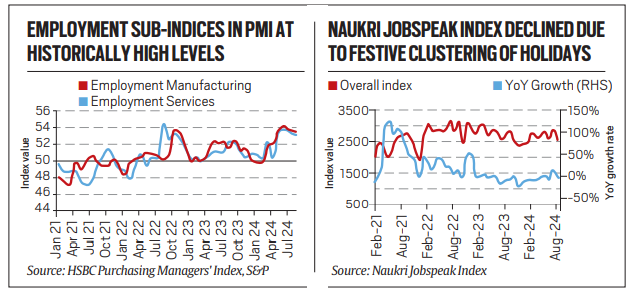
- Labour indicators show strong momentum, with EPFO adding 10.5 lakh new members in July, predominantly young first-time job seekers. However, Naukri’s JobSpeak index saw a slight contraction due to a unique clustering of holidays.
Economic Growth Outlook
Growth Projections
- High-frequency indicators and Q1 FY25 GDP growth of 6.7% align with the Ministry’s real GDP growth projection of 6.5-7% for FY25.
| PYQ: Economic growth in the recent past has been led by increase in labour productivity. Explain this statement. Suggest the growth pattern that will lead to creation of more jobs without compromising labour productivity. (UPSC CSE (M) GS-3 2022) |
| Practice Question: Discuss the recent signs of strain in India’s key sectors such as automobiles and FMCG as highlighted by the Ministry of Finance. How do these challenges affect the broader economic outlook, and what measures can be taken to mitigate these issues while sustaining the projected GDP growth? (250 words/15 m) |
PRELIMS FACTS
1. Keffiyeh: A Symbol of Palestinian Identity and Resistance Amid Controversy
(Source: Indian Express; Section: Explained; Page: 21)
| Context: |
| Indian-American author Jhumpa Lahiri declined an award from New York’s Noguchi Museum after it fired three employees for wearing keffiyeh scarves, associated with Palestinian nationhood and its resistance against Zionist occupation. |
Analysis of News:
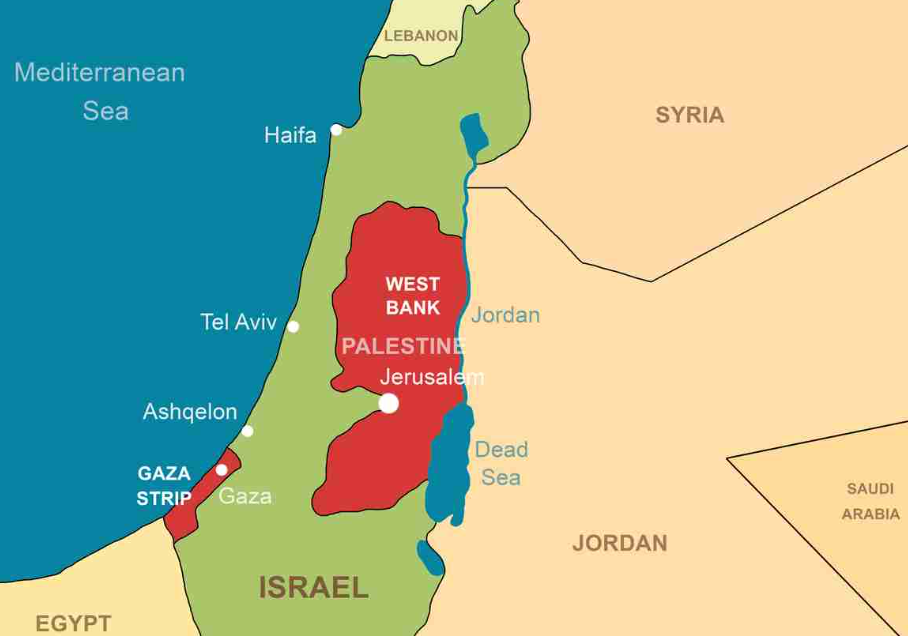
The Keffiyeh’s Cultural and Historical Significance
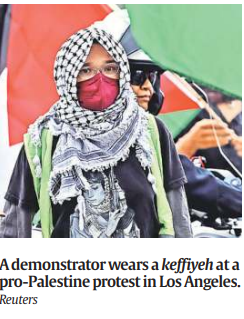
- Protection Against Desert Sun: Traditionally used in West Asia as protection from the sun, the keffiyeh is a white cotton scarf, featuring patterns symbolic of Palestinian culture, such as fishing nets and olive tree leaves.
- Symbol of Palestinian Identity: The keffiyeh evolved as a symbol of national unity and resistance in the 1930s during the British rule of Palestine. It gained further prominence after the 1948 displacement of Palestinians during the creation of Israel, embodying resilience and connection to their land.
- Popularization by Yasser Arafat: The Palestinian Liberation Organization (PLO) leader helped make the keffiyeh internationally recognizable in the 1970s.
Controversies and Bans on Keffiyehs
- Association with Palestinian Resistance: The keffiyeh has been long associated with opposition to Israel, leading to its ban in several Western contexts, such as in the Australian province of Victoria’s legislature.
- Symbolism in Fashion: In the 2000s, the keffiyeh became a fashion statement, with brands like Urban Outfitters and TopShop selling keffiyeh-like scarves, drawing criticism from Palestinians for cultural appropriation.
2. Japan’s Historic Naval Passage Through Taiwan Strait Sparks Tensions with China
(Source: Indian Express; Section: The World; Page: 18)
| Context: |
| Japan’s Self-Defense Force (SDF) destroyer Sazanami sailed through the Taiwan Strait for the first time, marking a historic event that angered China. The passage is seen as a message to Beijing amidst increasing regional tensions. |
Analysis of News:


Multinational Naval Collaboration
- The transit was conducted in collaboration with naval ships from Australia and New Zealand.
- The three countries are also scheduled for joint exercises in the South China Sea, highlighting coordinated regional defense efforts.
Japan’s Response to China’s Military Activity
Increased Military Presence
- Japan is responding to China’s growing military presence and territorial ambitions in the region by enhancing its defense capabilities.
- This move is part of Japan’s broader strategy to deter potential military actions from Beijing.
Concerns Over Airspace Violations
- Japanese officials have voiced concerns over repeated Chinese airspace violations, signaling a strong sense of urgency about the security situation in the region.
China’s Reaction
Criticism and Diplomatic Response
- China strongly criticized Japan’s passage through the Taiwan Strait, stating it violated the “one-China” principle and lodged formal diplomatic protests.
- Chinese officials urged Japan to act cautiously to avoid straining Sino-Japan relations and disturbing peace in the Taiwan Strait.
Regional Implications
Escalating Tensions
- This event highlights the increasing geopolitical tensions between Japan and China, with broader implications for regional security in East Asia, especially concerning Taiwan and maritime activities in the South China Sea.
3. L69, G4 countries seek urgent reform of UN Security Council
(Source – The Hindu, International Edition – Page No. – 1)
| Context |
| Ahead of the UN’s 80th anniversary, the G4 nations (India, Brazil, Germany, Japan) have renewed their push for urgent reforms to the UN Security Council (UNSC), calling for increased representation for developing countries.The L69 and C-10 groups also stressed the need for a more transparent and inclusive UNSC. |
G4 Nations
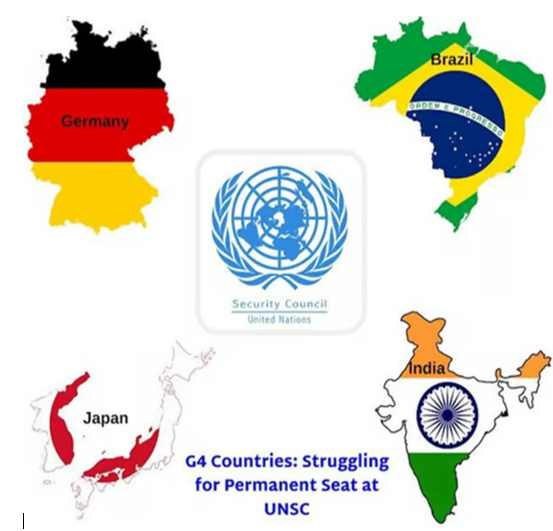
- Composition: The G4 comprises four nations: India, Brazil, Germany, and Japan.
- Purpose: Formed to advocate for reforms in the United Nations Security Council (UNSC).
- Goals: Seeks to secure permanent seats for its members in the UNSC to enhance representation.
- Advocacy: Emphasises the need for increased participation of developing countries in international decision-making.
- Global Relevance: Aims to address contemporary global challenges and improve the effectiveness of the UNSC.
L69 Group
- Composition: The L69 group includes developing countries from Asia, Africa, Latin America, and the Caribbean.
- Objective: Focused on advocating for comprehensive reforms of the UNSC.
- Representation: Stresses the importance of greater representation for the Global South.
- Significance: Aims to enhance the role of developing nations in maintaining global peace and security.
C-10 Group

Members of C-10
- Composition: The C-10, or Committee of Ten African Heads of State, represents African Union member countries.
- Focus: Advocates for the Common African Position regarding UNSC reforms.
- Demands: Calls for the allocation of two permanent and five non-permanent seats for African nations in the UNSC.
- Framework: The demands are based on the Ezulwini Consensus and the Sirte Declaration.
- Goal: Aims to ensure that Africa has a voice in international security matters and decision-making.
4. Karnataka govt. withdraws general consent to CBI to conduct probe
(Source – The Hindu, International Edition – Page No. – 1)
| Context |
| The Karnataka government has revoked its general consent for the CBIto investigate in the state, citing concerns of bias and misuse of power.This decision follows allegations against Chief Minister Siddaramaiah and reflects a broader trend among non-BJP ruled states. |

What is “General consent to CBI”?
- “General consent to CBI” refers to a legal provision that allows the Central Bureau of Investigation (CBI) to conduct investigations and file cases in a state without needing prior approval from the state’s government.
- Typically, under Section 6 of the Delhi Special Police Establishment Act, 1946, the CBI requires consent from the respective state government to exercise its powers.
- However, many states grant general consent, empowering the CBI to operate freely within their jurisdiction.
- This consent facilitates timely investigations into corruption and other serious crimes, though several states have recently withdrawn this consent, affecting CBI’s operational capabilities.
5. Exploring the ‘wonderful world’ of symplectic geometry to solve problems in mechanics
(Source – The Hindu, International Edition – Page No. – 4)
| Context |
| Yakov Eliashberg, a renowned mathematician, delivered a talk on “The strange and wonderful world of symplectic geometry” at IIT Madras.The program aims to enhance mathematical research in India, fostering collaboration and inspiration in pure mathematics. |
Symplectic Geometry
- Symplectic geometry is a branch of differential geometry that focuses on symplectic manifolds, which are smooth, even-dimensional spaces equipped with a closed, non-degenerate 2-form called the symplectic form.
- This geometric structure is essential in understanding the phase space of dynamical systems, making it crucial in various fields, including classical and quantum mechanics.
- Symplectic geometry captures the relationships between positions and momenta, facilitating the study of conservation laws and symmetries in physical systems.
Applications in Mechanics Problems:
- Hamiltonian Mechanics: Provides a framework to analyse dynamical systems using energy conservation.
- Phase Space Analysis: Represents states of a system in a compact, structured manner.
- Stability Studies: Helps determine the stability of equilibrium points in mechanical systems.
- Chaos Theory: Analyses complex, unpredictable systems through geometrical insights.
- Celestial Mechanics: Used to study planetary motion and gravitational interactions.
6. World Rabies Day: tracing the journey from myths to modern medicine
(Source – The Hindu, International Edition – Page No. – 7)
| Context |
| World Rabies Day, observed on September 28, highlights the evolution of rabies understanding, from ancient myths and superstitions to breakthroughs in vaccination by Louis Pasteur.It underscores the ongoing need for awareness, education, and medical advancements to control and eradicate this deadly disease. |

Rabies Information
- Cause: Rabies is a viral disease transmitted primarily through the bite or scratch of an infected animal, often dogs.
- Fatality: Nearly 100% fatal once symptoms appear, making it one of the deadliest infectious diseases.
Prevalence in India
- Global Share: India accounts for 33% of global rabies deaths.
- Annual Deaths: Around 59,000 deaths occur annually in India due to rabies.
- Source: 96% of cases are from dog bites, with stray dogs being a major contributor.
- Economic Impact: The cost of dog-mediated rabies in India is estimated at $8.6 billion annually.
Symptoms
- Initial Signs: Fever, headache, malaise, and discomfort around the bite site.
- Advanced Symptoms: Hyperactivity, hallucinations, paralysis, hydrophobia (fear of water), and difficulty swallowing.
- Outcome: Death occurs within days of symptom onset without prompt treatment.
Cure and Prevention
- Prevention: Immediate post-exposure prophylaxis (PEP) with a rabies vaccine and rabies immunoglobulin (Rabies Ig) for severe exposures (category 3).
- Vaccine Regimen: Four doses of the rabies vaccine are administered intradermally or intramuscularly over 28 days for unvaccinated individuals.
- Control Measures: Mass dog vaccination, public education, and animal population control are essential for rabies prevention in India.
7. Secretary, Dr. Devesh Chaturvedi chairs a review meeting of United Nations World Food Programme- Country Programme Advisory Committee
(Source – https://pib.gov.in/PressReleseDetail.aspx?PRID=2058889®=3&lang=1 )
| Context |
|
UN World Food Programme:
- Established: 1961 by the United Nations, headquartered in Rome, Italy.
- Objective: To combat global hunger, improve food security, and enhance nutrition in crisis and vulnerable regions.
- Operations: Active in over 80 countries, delivering food assistance during emergencies and working on long-term development projects.
- Key Focus Areas:
- Emergency response: Provides immediate food aid in disaster-affected and conflict regions.
- Resilience building: Supports sustainable agriculture, climate adaptation, and food systems.
- Nutrition: Promotes access to nutritious, fortified foods, focusing on children, women, and vulnerable communities.
- Partnerships: Collaborates with governments, NGOs, and other UN agencies.
- Notable Achievements: Awarded the Nobel Peace Prize in 2020 for efforts to combat hunger and prevent the use of food as a weapon in conflicts.



